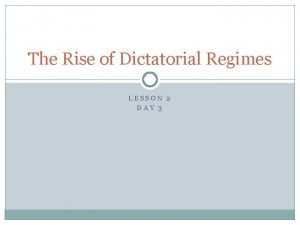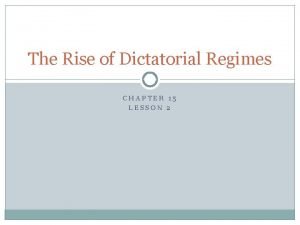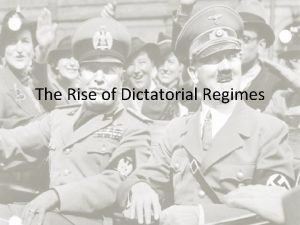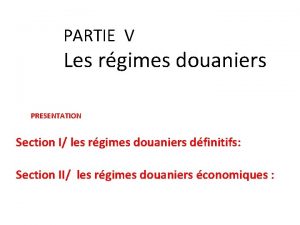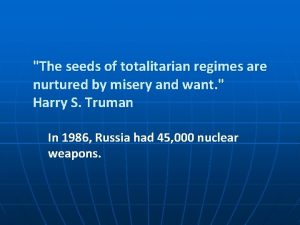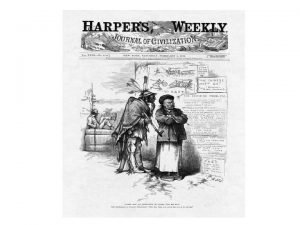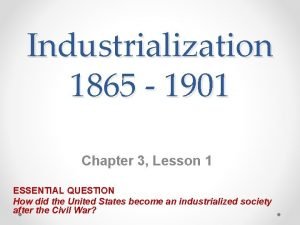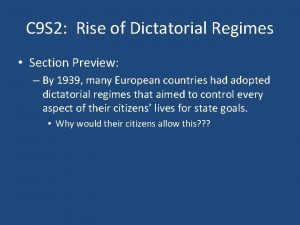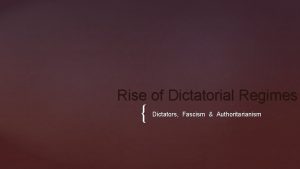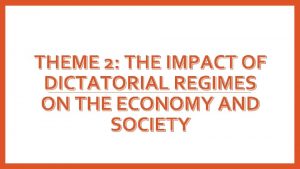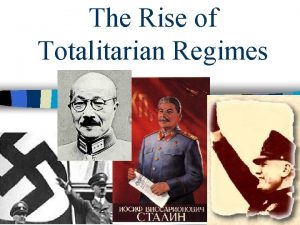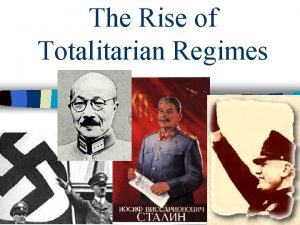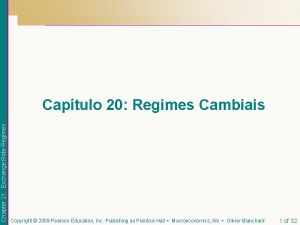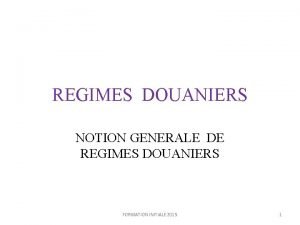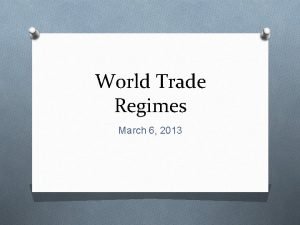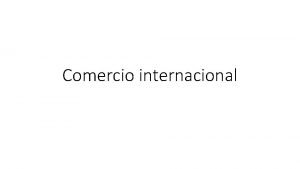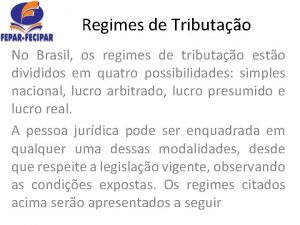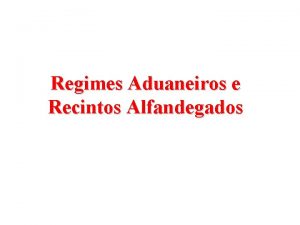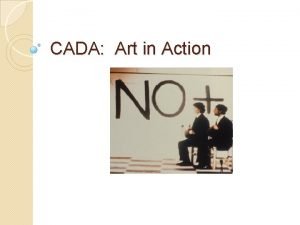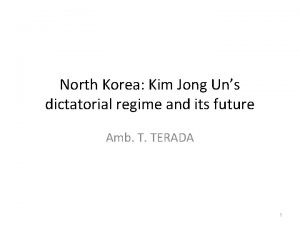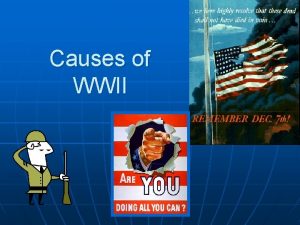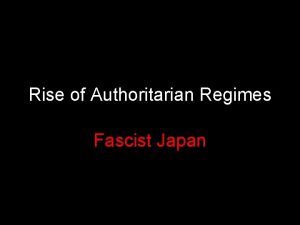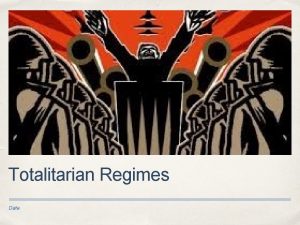Ch 15 Lesson 2 Rise of Dictatorial Regimes























- Slides: 23

Ch. 15 Lesson 2 Rise of Dictatorial Regimes

Bellringer ▪ How would you define these two terms in your own words? 1) Dictator; and 2) Totalitarian state

Vocabulary Possible answers: ▪ Dictator—a ruler who has absolute power ▪ Totalitarian state—government aiming to control every aspect of daily life; to control the political, economic, social, intellectual, and cultural lives of citizens In this lesson, you will learn about the rise of such regimes in the years following WWI.

Objective ▪ Students will be able to 1) understand fascism; and 2) explain how fascist Mussolini created a dictatorial state in Italy.

Intro ▪ By 1939, only two major European states remained democratic Great Britain and France ▪ Italy, the Soviet Union (Russia), and Germany adopted dictatorial regimes.

Totalitarian States ▪ Totalitarianism is a form of government that holds total power over the people, controlling every aspect of daily life. ▪ *The goal of totalitarian regimes was to conquer the minds and hearts of the people. They achieved this goal by using mass propaganda techniques and modern communications. *

Characteristics of Totalitarian States ▪ New totalitarian states were formed in which a one-party dictatorship attempted to control every aspect of the lives of its citizens. Individual freedoms and equality were rejected. What do you think is expected of citizens in a totalitarian state?

Bellwork ▪ Study for great depression quiz. I will give you five minutes after the bell, and you will have five minutes on the quiz. ▪ After you finish quiz be ready to take notes.

Italy

Rise of Fascism in Europe ▪ Fascism glorifies the state above the individual by emphasizing a strong central government led by a dictator; is rooted in extreme nationalism; believes in militarism, discipline, and blind loyalty to the state ▪ Led by dictator Mussolini, Italy became the first fascist state in Europe.

▪ After World War I, Italian nationalists were outraged when Italy received just some of the territories promised by the Allies. Chaos ensued as peasants seized land, workers went on strike, veterans faced unemployment, trade declined, and taxes rose. ▪ To gain popular support for his cause, Mussolini appealed to Italian anger over the peace treaty not giving more land to Italy. He later became dictator.

Mussolini Control ▪ Mussolini used his secret police to control the general population. He suppressed rivals, muzzled the press, and replaced elected officials with Fascists, and rigged elections. His critics were jailed, forced into exile, or murdered. ▪ Youth groups indoctrinated children into the fascist ideology. ▪ On the other hand, Mussolini maintained traditional attitudes toward the family and the Catholic Church. Women were expected to focus on motherhood and homemaking. Men=Loyal Soldiers

Mussolini Control ▪ He spread propaganda through the use of mass media, including newspapers and radio. (slogan: “Mussolini is Always Right; ” “Believe! Obey! Fight!”) ▪ These slogans were blasted on loudspeakers and placed on posters.

Image Analysis

Objective ▪ Students will be able to explain how the Soviet Union was created and how Stalin gained power and maintained power there.

From Russia to the USSR ▪ Beginning in 1920, a drought in Russia led to famine and agricultural collapse, which led to industrial collapse. Hoarding of food added to the crisis. Peasants would chant, “Down with Lenin and horse flesh, bring back the czar and pork” ▪ Vladimir Lenin was forced to move away from war communism and adopt the capitalist New Economic Policy (NEP) to avert a complete economic disaster. Peasants were allowed to sell their crops, and some people were allowed to own their own small businesses.

The Soviet Union ▪ Along with the NEP, the end of the drought brought economic recovery. Harvests improved. In 1922, Lenin renamed Russia the Union of Soviet Socialist Republics (USSR), or Soviet Union. ▪ Lenin died in 1924, and a struggle for power in the Soviet Union began.

Background Knowledge ▪ Lenin's death in 1924 led to a power struggle between Joseph Stalin and War Commissar Leon Trotsky wanted to end the NEP and focus on industrialization as well as worldwide communist revolution. Stalin used his post as general secretary of the Communist Party to gain complete control of the party, appointing officials who supported him, and removing or killing those who disagreed with him. ▪ Stalin removed from government the Bolsheviks of the revolutionary era and created a rigid dictatorship. He shifted economic policy in 1928, ending the NEP and launching the first of several Five-Year Plans to promote industrialization.

Costs of Stalin’s Programs ▪ Stalin focused on rapid industrialization. With that came horrible living conditions for millions of workers and families. ▪ He also focused on rapid collectivization of agriculture (a system in which private farms were eliminated). Government owned the land the peasants had to work it. ▪ Famine occurred in 1932, resulting in around 10 million peasants dying. Known as the Terror Famine, Stalin engineered to get rid of the peasants who opposed collectivization.

Purges ▪ Stalin used secret police, torture, and bloody purges to force people to obey. Those who opposed Stalin were rounded up and sent to the Gulag, a system of brutal labor camps, in Siberia. ▪ Fearing that rival party leaders were plotting against him, Stalin launched the Great Purge in 1934. Among the victims of this and other purges were some of the brightest and most talented people in the country. ▪ About 8 million people were arrested. Millions were sent to forced labor camps in Siberia and never returned. Many others were executed.

Bio

Stalin ▪ Questions: 1)Describe Stalin’s leadership style? 2)How did Stalin cause millions of deaths during his time as dictator?

Exit Ticket ▪ Describe in one sentence who came to power in Russia after Lenin died and how did he rule his country.
 Lesson 2 the rise of dictatorial regimes
Lesson 2 the rise of dictatorial regimes Chapter 15 lesson 2 the rise of dictatorial regimes
Chapter 15 lesson 2 the rise of dictatorial regimes The rise of dictatorial regimes
The rise of dictatorial regimes Rise and rise until lambs become lions
Rise and rise until lambs become lions Tricky dicky richard nixon
Tricky dicky richard nixon Rise and rise again until lambs become lions
Rise and rise again until lambs become lions Rise and rise again until lambs become lions origin
Rise and rise again until lambs become lions origin Régimes douaniers
Régimes douaniers The seeds of totalitarian regimes are nurtured
The seeds of totalitarian regimes are nurtured Who is this man
Who is this man The rise of civilization lesson 2 the neolithic revolution
The rise of civilization lesson 2 the neolithic revolution Lesson 1 the rise of industry
Lesson 1 the rise of industry Lesson outline lesson 3 describing circuits answers
Lesson outline lesson 3 describing circuits answers Kind of fault
Kind of fault Lesson outline lesson 2 aquatic ecosystems answer key
Lesson outline lesson 2 aquatic ecosystems answer key Macro lesson plan
Macro lesson plan Ihi leadership alliance
Ihi leadership alliance Where did ravi hide the kitten
Where did ravi hide the kitten Chapter 1 lesson 1 your total health lesson 1 quiz
Chapter 1 lesson 1 your total health lesson 1 quiz Weather forecasts lesson 3 outline answers
Weather forecasts lesson 3 outline answers Sat vocabulary lesson 4
Sat vocabulary lesson 4 Lesson 2 physical properties answer key
Lesson 2 physical properties answer key The science duo physical and chemical changes
The science duo physical and chemical changes Lesson outline climates of earth
Lesson outline climates of earth
